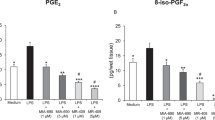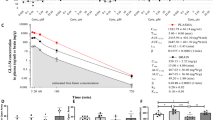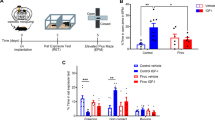Abstract
Anxiety and depression have been suggested to increase the risk for post-traumatic stress disorders (PTSD). A link between all these mental illnesses, inflammation and oxidative stress is also well established. Recent behavior studies by our group clearly demonstrate a powerful anxiolytic and antidepressant-like effects of a novel growth hormone releasing hormone (GHRH) antagonist of MIAMI class, MIA-690, probably related to modulatory effects on the inflammatory and oxidative status. In the present work we investigated the potential beneficial effects of MIA-602, another recently developed GHRH antagonist, in mood disorders, as anxiety and depression, and the possible brain pathways involved in its protective activity, in adult mice. MIA-602 exhibited antinflammatory and antioxidant effects in ex vivo and in vivo experimental models, inducing anxiolytic and antidepressant-like behavior in mice subcutaneously treated for 4 weeks. The beneficial effect of MIA-602 on inflammatory and oxidative status and synaptogenesis resulting in anxiolytic and antidepressant-like effects could be related by increases of nuclear factor erythroid 2-related factor 2 (Nrf2) and of brain-derived neurotrophic factor (BDNF) signaling pathways in the hippocampus and prefrontal cortex. These results strongly suggest that GHRH analogs should be tried clinically for the treatment of mood disorders including PTSD.
This is a preview of subscription content, access via your institution
Access options
Subscribe to this journal
Receive 12 print issues and online access
$259.00 per year
only $21.58 per issue
Buy this article
- Purchase on Springer Link
- Instant access to full article PDF
Prices may be subject to local taxes which are calculated during checkout





Similar content being viewed by others
References
Kessler RC, Chiu WT, Demler O, Merikangas KR, Walters EE. Prevalence, severity, and comorbidity of 12-month DSM-IV disorders in the national comorbidity survey replication. Arch Gen Psychiatry. 2005;62:617–27.
Kalin NH. The critical relationship between anxiety and depression. Am J Psychiatry. 2020;177:365–7.
Kessler RC, Sampson NA, Berglund P, Gruber MJ, Al-Hamzawi A, Andrade L, et al. Anxious and non-anxious major depressive disorder in the World Health Organization World Mental Health Surveys. Epidemiol Psychiatr Sci. 2015;24:210–26.
Kessler RC, Sonnega A, Bromet E, Hughes M, Nelson CB. Posttraumatic stress disorder in the National Comorbidity Survey. Arch Gen Psychiatry. 1995;52:1048–60.
Dunner DL. Management of anxiety disorders: the added challenge of comorbidity. Depress Anxiety. 2001;13:57–71.
Dold M, Bartova L, Souery D, Mendlewicz J, Serretti A, Porcelli S, et al. Clinical characteristics and treatment outcomes of patients with major depressive disorder and comorbid anxiety disorders: results from a European multicenter study. J Psychiatr Res. 2017;91:1–13.
Tamagno G, Epelbaum J. Editorial: neurological and psychiatric disorders in endocrine diseases. Front Endocrinol (Lausanne). 2015;6:101.
Kokshoorn NE, Biermasz NR, Roelfsema F, Smit JW, Pereira AM, Romijn JA. GH replacement therapy in elderly GH-deficient patients: a systematic review. Eur J Endocrinol. 2011;164:657–65.
Prodam F, Caputo M, Belcastro S, Garbaccio V, Zavattaro M, Samà MT, et al. Quality of life, mood disturbances and psychological parameters in adult patients with GH deficiency. Panminerva Med. 2012;54:323–31.
Recinella L, Chiavaroli A, Orlando G, Ferrante C, Marconi GD, Gesmundo I, et al. Antinflammatory, antioxidant, and behavioral effects induced by administration of growth hormone-releasing hormone analogs in mice. Sci Rep. 2020;10:4850.
Engin E, Stellbrink J, Treit D, Dickson CT. Anxiolytic and antidepressant effects of intracerebroventricularly administered somatostatin: behavioral and neurophysiological evidence. Neuroscience. 2008;157:666–76.
Yeung M, Treit D. The anxiolytic effects of somatostatin following intra-septal and intra-amygdalar microinfusions are reversed by the selective sst2 antagonist PRL2903. Pharm Biochem Behav. 2012;101:88–92.
Leone S, Shohreh R, Manippa F, Recinella L, Ferrante C, Orlando G, et al. Behavioural phenotyping of male growth hormone-releasing hormone (GHRH) knockout mice. Growth Horm IGF Res. 2014;24:192–7.
Schally AV, Zhang X, Cai R, Hare JM, Granata R, Bartoli M. Actions and potential therapeutic applications of growth hormone-releasing hormone agonists. Endocrinology. 2019;160:1600–12.
Villanova T, Gesmundo I, Audrito V, Vitale N, Silvagno F, Musuraca C, et al. Antagonists of growth hormone-releasing hormone (GHRH) inhibit the growth of human malignant pleural mesothelioma. Proc Natl Acad Sci USA. 2019;116:2226–31.
Zarandi M, Cai R, Kovacs M, Popovics P, Szalontay L, Cui T, et al. Synthesis and structure-activity studies on novel analogs of human growth hormone releasing hormone (GHRH) with enhanced inhibitory activities on tumor growth. Peptides. 2017;89:60–70.
Recinella L, Chiavaroli A, Orlando G, Menghini L, Ferrante C, Di Cesare ML. et al. Protective effects induced by two polyphenolic liquid complexes from olive (Olea europaea, mainly Cultivar Coratina) pressing juice in rat isolated tissues challenged with LPS. Molecules. 2019;24:E3002.
Ferrante C, Orlando G, Recinella L, Leone S, Chiavaroli A, Di Nisio C, et al. Central apelin-13 administration modulates hypothalamic control of feeding. J Biol Regul Homeost Agents. 2016;30:883–8.
Recinella L, Shohreh R, Salvatori R, Orlando G, Vacca M, Brunetti L. Effects of isolated GH deficiency on adipose tissue, feeding and adipokines in mice. Growth Horm IGF Res. 2013;23:237–42.
Leone S, Chiavaroli A, Shohreh R, Ferrante C, Ricciuti A, Manippa F, et al. Increased locomotor and thermogenic activity in mice with targeted ablation of the GHRH gene. Growth Horm IGF Res. 2015;25:80–4.
Leone S, Recinella L, Chiavaroli A, Ferrante C, Orlando G, Vacca M, et al. Behavioural phenotyping, learning and memory in young and aged growth hormone-releasing hormone-knockout mice. Endocr Connect. 2018;7:924–31.
Chiavaroli A, Recinella L, Ferrante C, Martinotti S, Vacca M, Brunetti L, et al. Effects of central fibroblast growth factor 21 and irisin in anxiety-like behavior. J Biol Regul Homeost Agents. 2017;31:797–802.
Leone S, Recinella L, Chiavaroli A, Martinotti S, Ferrante C, Mollica A, et al. Emotional disorders induced by Hemopressin and RVD-hemopressin(α) administration in rats. Pharm Rep. 2017;69:1247–53.
Recinella L, Chiavaroli A, Ferrante C, Mollica A, Macedonio G, Stefanucci A, et al. Effects of central RVD-hemopressin(α) administration on anxiety, feeding behavior and hypothalamic neuromodulators in the rat. Pharm Rep. 2018;70:650–7.
Paxinos G, Watson C. The Rat Brain in Stereotaxic Coordinates. 6th ed. Elsevier Academy Press: 2007.
Di Giulio C, Marconi GD, Zara S, Di Tano A, Porzionato A, Pokorski M, et al. Selective expression of galanin in neuronal-like cells of the human carotid body. Adv Exp Med Biol. 2015;860:315–23.
Veschi S, De Lellis L, Florio R, Lanuti P, Massucci A, Tinari N, et al. Effects of repurposed drug candidates nitroxoline and nelfinavir as single agents or in combination with erlotinib in pancreatic cancer cells. J Exp Clin Cancer Res. 2018;37:236.
Livak KJ, Schmittgen TD. Analysis of relative gene expression data using real- time quantitative PCR and the 2(-Delta Delta C(T)) Method. Methods 2001;25:402–8.
Barabutis N, Schally AV, Siejka A. P53, GHRH, inflammation and cancer. EBioMed. 2018;37:557–62.
Barabutis N, Schally AV. Antioxidant activity of growth hormone-releasing hormone antagonists in LNCaP human prostate cancer line. Proc Natl Acad Sci USA. 2008;105:20470–5.
Popovics P, Cai R, Sha W, Rick FG, Schally AV. Growth hormone-releasing hormone antagonists reduce prostatic enlargement and inflammation in carrageenan-induced chronic prostatitis. Prostate. 2018;78:970–80.
Qin YJ, Chan SO, Chong KK, Li BF, Ng TK, Yip YW, et al. Antagonist of GH-releasing hormone receptors alleviates experimental ocular inflammation. Proc Natl Acad Sci USA. 2014;111:18303–8.
Ren JL, Yu QX, Ma D, Liang WC, Leung PY, Ng TK, et al. Growth hormone-releasing hormone receptor mediates cytokine production in ciliary and iris epithelial cells during LPS-induced ocular inflammation. Exp Eye Res. 2019;181:277–84.
Zhang C, Cai R, Lazerson A, Delcroix G, Wangpaichitr M, Mirsaeidi M, et al. Growth hormone-releasing hormone receptor antagonist modulates lung inflammation and fibrosis due to bleomycin. Lung. 2019;197:541–9.
Banks WA, Morley JE, Farr SA, Price TO, Ercal N, Vidaurre I, et al. Effects of a growth hormone-releasing hormone antagonist on telomerase activity, oxidative stress, longevity, and aging in mice. Proc Natl Acad Sci USA. 2010;107:22272–7.
Fahrenholtz CD, Rick FG, Garcia MI, Zarandi M, Cai R, Block NL, et al. Preclinical efficacy of growth hormone-releasing hormone antagonists for androgen-dependent and castration-resistant human prostate cancer. Proc Natl Acad Sci USA. 2014;111:1084–9.
Vitiello MV, Moe KE, Merriam GR, Mazzoni G, Buchner DH, Schwartz RS. Growth hormone releasing hormone improves the cognition of healthy older adults. Neurobiol Aging. 2006;27:318–23.
Baker LD, Barsness SM, Borson S, Merriam GR, Friedman SD, Craft S, et al. Effects of growth hormone–releasing hormone on cognitive function in adults with mild cognitive impairment and healthy older adults: results of a controlled trial. Arch Neurol. 2012;69:1420–9.
Kalueff AV, Wheaton M, Murphy DL. What’s wrong with my mouse model? Advances and strategies in animal modeling of anxiety and depression. Behav Brain Res. 2007;179:1–18.
Matsubara S, Sato M, Mizobuchi M, Niimi M, Takahara J. Differential gene expression of growth hormone (GH)-releasing hormone (GRH) and GRH receptor in various rat tissues. Endocrinology. 1995;136:4147–50.
Müller EE, Locatelli V, Cocchi D. Neuroendocrine control of growth hormone secretion. Physiol Rev. 1999;79:511–607.
Hallschmid M, Wilhelm I, Michel C, Perras B, Born J. A role for central nervous growth hormone-releasing hormone signaling in the consolidation of declarative memories. PLoS One. 2011;6:e23435.
Telegdy G, Tanaka M, Schally AV. Effects of the growth hormone-releasing hormone (GH-RH) antagonist on brain functions in mice. Behav Brain Res. 2011;24:155–8.
Telegdy G, Schally AV. Involvement of neurotransmitters in the action of growth hormone-releasing hormone antagonist on passive avoidance learning. Behav Brain Res. 2012;233:326–30.
Telegdy G, Schally AV. Neurotransmitter-mediated action of an antagonist of growth hormone-releasing hormone on anxiolysis in mice. Behav Brain Res. 2012;233:232–6.
Jaszberenyi M, Rick FG, Szalontay L, Block NL, Zarandi M, Cai R, et al. Beneficial effects of novel antagonists of GHRH in different models of Alzheimer’s disease. Aging (Albany NY). 2012;4:755–67.
Arwert LI, Veltman DJ, Deijen JB, van Dam PS, Delemarre-van deWaal HA, Drent ML. Growth hormone deficiency and memory functioning in adults visualized by functional magnetic resonance imaging. Neuroendocrinology. 2005;82:32–40.
Engin E, Treit D. Anxiolytic and antidepressant actions of somatostatin: the role of sst2 and sst3 receptors. Psychopharmacol (Berl). 2009;206:281–9.
Genzel L, Dresler M, Cornu M, Jäger E, Konrad B, Adamczyk M, et al. Medial prefrontal-hippocampal connectivity and motor memory consolidation in depression and schizophrenia. Biol Psychiatry. 2015;77:177–86.
Godsil BP, Kiss JP, Spedding M, Jay TM. The hippocampal-prefrontal pathway: the weak link in psychiatric disorders? Eur Neuropsychopharmacol. 2013;23:1165–81.
Li M, Long C, Yang L. Hippocampal-prefrontal circuit and disrupted functional connectivity in psychiatric and neurodegenerative disorders. Biomed Res Int. 2015;2015:810548.
Fenster RJ, Lebois LAM, Ressler KJ, Suh J. Brain circuit dysfunction in post-traumatic stress disorder: from mouse to man. Nat Rev Neurosci. 2018;19:535–51.
Mendez-David I, Tritschler L, El Ali Z, Damiens MH, Pallardy M, David DJ, et al. Nrf2-signaling and BDNF: A new target for the antidepressant-like activity of chronic fluoxetine treatment in a mouse model of anxiety/depression. Neurosci Lett. 2015;597:121–6.
Green CR, Corsi-Travali S, Neumeister A. The role of BDNF-TrkB signaling in the pathogenesis of PTSD. J Depress Anxiety. 2013;2013:006.
Prasadan KN, Bondy SC. Common biochemical defects linkage between post-traumatic stress disorders, mild traumatic brain injury (TBI) and penetrating TBI. Brain Res. 2015;1599:103–14.
Kensler TW, Wakabayashi N, Biswal S. Cell survival responses to environmental stresses via the Keap1-Nrf2-ARE pathway. Annu Rev Pharm Toxicol. 2007;47:89–116.
Kobayashi EH, Suzuki T, Funayama R, Nagashima T, Hayashi M, Sekine H, et al. Nrf2 suppresses macrophage inflammatory response by blocking proinflammatory cytokine transcription. Nat Commun. 2016;7:11624.
Ma Q. Role of nrf2 in oxidative stress and toxicity. Annu Rev Pharm Toxicol. 2013;53:401–26.
Hashimoto K. Essential role of Keap1-Nrf2 signaling in mood disorders: overview and future perspective. Front Pharm. 2018;9:1182.
Martín-de-Saavedra MD, Budni J, Cunha MP, Gómez-Rangel V, Lorrio S, Del Barrio L, et al. Nrf2 participates in depressive disorders through an anti-inflammatory mechanism. Psychoneuroendocrinology. 2013;38:2010–22.
Dowlati Y, Herrmann N, Swardfager W, Liu H, Sham L, Reim EK, et al. A meta-analysis of cytokines in major depression. Biol Psychiatry. 2010;67:446–57.
Howren MB, Lamkin DM, Suls J. Associations of depression with C-reactive protein, IL-1, and IL-6: a meta-analysis. Psychosom Med. 2009;71:171–86.
Pace TW, Wingenfeld K, Schmidt I, Meinlschmidt G, Hellhammer DH, Heim CM. Increased peripheral NF-kappaB pathway activity in women with childhood abuse-related posttraumatic stress disorder. Brain Behav Immun. 2012;26:13–7.
Ogłodek EA, Just MJ. The association between inflammatory markers (iNOS, HO-1, IL-33, MIP-1β) and depression with and without posttraumatic stress disorder. Pharm Rep. 2018;70:1065–72.
Schinder AF, Poo M. The neurotrophin hypothesis for synaptic plasticity. Trends Neurosci. 2000;23:639–45.
Reinhart V, Bove S, Volfson D, Lewis D, Kleiman R, Lanz T. Evaluation of TrkB and BDNF transcripts in prefrontal cortex, hippocampus, and striatum from subjects with schizophrenia, bipolar disorder, and major depressive disorder. Neurobiol Dis. 2015;77:220–7.
Rakofsky J, Ressler K, Dunlop B. BDNF function as a potential mediator of bipolar disorder and post-traumatic stress disorder comorbidity. Mol Psychiatry. 2012;17:22–35.
Matrisciano F, Bonaccorso S, Ricciardi A, Scaccianoce S, Panaccione I, Wang L, et al. Changes in BDNF serum levels in patients with major depression disorder (MDD) after 6 months treatment with sertraline, escitalopram, or venlafaxine. J Psychiatr Res. 2009;43:247–54.
Saarelainen T, Hendolin P, Lucas G, Koponen E, Sairanen M, MacDonald E, et al. Activation of the TrkB neurotrophin receptor is induced by antidepressant drugs and is required for antidepressant-induced behavioral effects. J Neurosci. 2003;23:349–57.
Zhou C, Zhong J, Zou B, Fang L, Chen J, Deng X, et al. Meta-analyses of comparative efficacy of antidepressant medications on peripheral BDNF concentration in patients with depression. PLoS One. 2017;12:e0172270.
Binder DK, Scharfman HE. Brain-derived neurotrophic factor. Growth Factors. 2004;22:123–31.
Verbitsky A, Dopfel D, Zhang N. Rodent models of post-traumatic stress disorder: behavioral assessment. Transl Psychiatry. 2020;10:132.
Acknowledgements
This work was supported by the University G. d’Annunzio of Chieti FAR 2020 (to Sheila Leone) and FAR 2020 (to Lucia Recinella). Work in Miami was supported by the Medical Research Service of the Department of Veterans Affairs and by the University of Miami Miller School of Medicine (to Andrew V. Schally).
Author information
Authors and Affiliations
Contributions
LR, AVS, LB and SL conceived and coordinated the study and wrote the paper; AC (Annalisa Chiavaroli) performed ex vivo studies, in vivo studies and gene expression analysis and analyzed the data; GO, CF, IG and RG analyzed the data; SV and AC (Alessandro Cama) performed western blot analysis and analyzed the data; GDM and FD performed haematoxylin-eosin staining/light microscopy analysis and immunohistochemistry; RC, WS and AVS contributed new reagents. All authors revised and approved the final version of manuscript.
Corresponding authors
Ethics declarations
Competing interests
AVS and RC are listed as co-inventors on patents for GHRH antagonists, assigned to the University of Miami, Miami, FL, and the Veterans Affairs Medical Center, Miami, FL. LR, AC, GO, CF, SV, AC, GDM, FD, IG, RG, WS, LB, and SL declare no potential conflict of interest.
Additional information
Publisher’s note Springer Nature remains neutral with regard to jurisdictional claims in published maps and institutional affiliations.
Supplementary information
Rights and permissions
About this article
Cite this article
Recinella, L., Chiavaroli, A., Orlando, G. et al. Effects of growth hormone-releasing hormone receptor antagonist MIA-602 in mice with emotional disorders: a potential treatment for PTSD. Mol Psychiatry 26, 7465–7474 (2021). https://doi.org/10.1038/s41380-021-01228-5
Received:
Revised:
Accepted:
Published:
Issue Date:
DOI: https://doi.org/10.1038/s41380-021-01228-5



